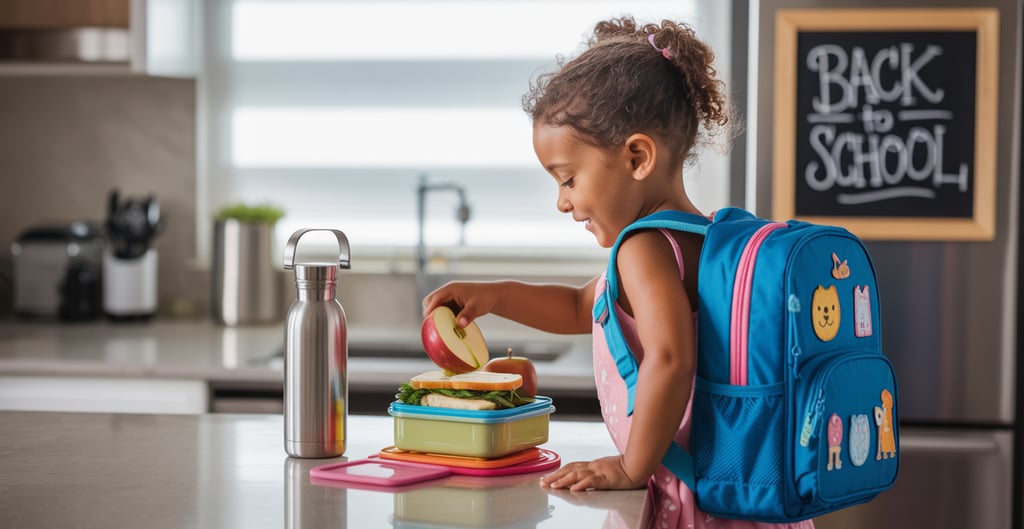Back to School Food Safety Tips
As kids head back to the classroom, it’s the perfect time to reinforce important habits that go far beyond good grades, starting with basic hygiene. From clean hands to safe eating habits, teaching your child the “why” behind these actions helps protect their health and builds responsibility early on. These everyday practices can prevent the spread of germs both at home and at school. By making hygiene part of their routine, children gain confidence and independence in taking care of themselves. Food safety is a major part of that conversation, especially when school lunches, snacks, and packed meals are involved. Whether your child eats in the cafeteria, takes a homemade lunch, or grabs a snack from their backpack, these moments are opportunities to teach lasting lessons that help keep them healthy.
7/28/20253 min read


1. Start with Hygiene: Teach and Repeat
Food safety starts with personal hygiene, and children should be reminded often about the importance of keeping clean before and during mealtime.
Teach These Basic Habits:
Wash hands before eating and after using the restroom
Don’t eat food that’s dropped on desks, the floor, or shared trays
Don’t share food or drinks with classmates (even close friends!)
Wipe hands and surfaces clean before eating
Close containers fully before storing leftovers or tossing waste
Even if your child eats in a supervised cafeteria, these habits are critical for long-term health and confidence. Consider posting a checklist on the fridge or reviewing these routines weekly during the first few months of school.
2. Clean Hands, Clean Surfaces
Food safety begins before you even touch an ingredient.
Wash Hands Thoroughly
Always wash your hands with soap and warm water for at least 20 seconds before preparing meals or snacks.
Teach your child to do the same before they eat, especially if they’re eating lunch without access to a sink. If soap and water aren’t available, make sure they carry wet wipes or hand sanitizer in their lunchbox or backpack as a backup. Clean hands are the first line of defense against germs, at home, at school, or on the go.
Clean Lunch Tools
Lunchboxes, containers, and reusable utensils should be cleaned with hot, soapy water every day. Bacteria can grow on surfaces overnight, especially if moisture is present.
3. Pack Perishables Properly
Perishable foods, like meats, dairy, and cut fruits, need to stay cool to prevent the growth of harmful bacteria.
Use an Insulated Lunch Bag
Insulated soft-sided lunch bags are more effective at keeping food cold than plastic or paper bags. Combine them with ice packs to maintain a safe temperature (below 40°F / 4°C).
Add Multiple Cold Sources
For extra protection, include a frozen juice box, frozen yogurt tube, or multiple cold packs. This keeps the entire lunch cold longer, especially if lunch isn’t eaten until later in the day.
4. Keep Hot Foods Hot
If your child prefers hot lunches like soup, chili, or pasta, proper insulation is key.
Use a Preheated Thermos
Before filling a thermos, rinse it with boiling water and let it sit for a few minutes. Then add your heated food (at least 165°F / 74°C) and seal it tightly.
No Lukewarm Meals
Avoid lukewarm food, it’s the danger zone (40°F–140°F), where bacteria thrive. Foods should be kept hot or cold, not in between.
5. Smart Food Choices for Safety
If refrigeration or reheating isn’t available, opt for shelf-stable or low-risk options.
Safer Lunch Ideas:
Peanut butter and jelly
Whole fruits (bananas, apples, oranges)
Veggie wraps with hummus
Crackers with shelf-stable cheese
Dry cereal or granola
❌ Skip These Without Cooling:
Mayo-based salads
Unrefrigerated dairy
Cooked meats or leftovers without insulation
6. Avoid Cross-Contamination
Cross-contamination is a top cause of foodborne illness.
Use Separate Containers
Keep raw fruits/veggies separate from proteins or moist items. Use bento-style boxes or individual containers.
Don’t Reuse Foil or Bags
Throw away or thoroughly wash anything that met food. Don’t reuse sandwich bags from the day before.
7. Prep Safe, Store Smart
Fridge Storage
Don’t leave lunchboxes on the counter overnight. Store packed lunches in the fridge, then add ice packs in the morning.
Morning Tip
Chill the entire lunchbox the night before. It will help keep everything colder for longer when combined with an ice pack.
8. Train Kids in Food Safety Too
Even young kids can understand what spoiled food looks and smells like.
Teach Kids:
If something smells “off,” throw it away
If food is warm when it should be cold, don’t eat it
Don’t save leftovers from lunch for after school
Always seal containers and bottles tightly
These tips encourage safe habits while helping them feel more in control of their choices.
9. Check for Spoilage Signs
Train your child to spot:
Strange smells
Mushy textures
Unusual colors
Containers that feel warm instead of cold
A quick check can prevent hours of stomach trouble later.
10. Lunch Packing Checklist
Here’s your daily reminder:
✅ Hands washed
✅ Clean containers
✅ Ice packs added
✅ Safe, non-risky food selected
✅ Everything stored in fridge until leaving
✅ Kids reminded of safety rules
Back to school means more than just pencils and backpacks. It’s also the time to instill strong food safety habits that last a lifetime. With a few mindful choices, your child’s lunch can be just as safe as it is tasty.
Start this school year with peace of mind, one lunchbox at a time.
Join us on Pinterest
letstalk@lorybs.com
© 2025. All rights reserved.
